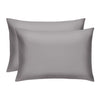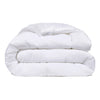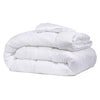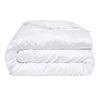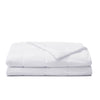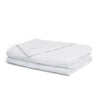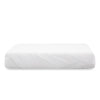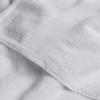The Daily Miracle
Who Invented the Bed: The History Explained
Published
November 01, 2023
Author
Bridget Reed

Ever wondered who we have to thank for our cozy nights? The history of the bed is a fascinating intersection of human innovation, cultural shifts, and the relentless pursuit of comfort. It's a tale that takes us from prehistoric caves to Egyptian palaces, from medieval castles to modern high-tech bedrooms.
And while the specifics may differ across time and geography, the essential goal remains the same: to create a space for restful slumber. Alongside the evolution of the bed itself, we've seen an array of bedding products designed to elevate the quality of sleep.
We're talking about intricately embroidered quilts, sumptuous pillows, and, yes, even NASA-inspired fabrics. From the engineers dreaming up more ergonomic designs to the artisans weaving luxurious textiles, many talents and visions have culminated in today's sleep experience.
As we dive into the history of the bed, take a moment to consider the place where your day both starts and ends. Think of it as an opportunity to appreciate the nuances and complexities that have brought us to this point in sleep innovation.
The Birth of the Bed
Long before the era of soft, cloud-like mattresses, our ancestors made do with what nature provided. Whether that was a bed of leaves, a ground hollowed out to accommodate the human form, or an improvised hammock made of woven vines. The primary goal was straightforward — find a place to lie down and rest.
In ancient Egypt, elevated platforms made of palm branches or woven reeds were quite popular, fulfilling both functional and aesthetic needs. These platforms kept sleepers off the ground, away from vermin and insects, and even allowed for better air circulation during hot nights.
In a similar vein, the Romans had their own version of comfort. Beds were generally made with wooden frames and strung with ropes tightened to create a mesh-like support system.
Over time, Roman beds grew more elaborate, with mattresses filled with wool, feathers, or even straw. These mattresses rested on the rope mesh, transforming the beds into more than just a place to sleep — they became a testament to the wealth and status of the owner.
But beds weren't always static fixtures in one's abode. Nomadic cultures often employed collapsible bed frames made of light materials like wood or bone, making it easier to break camp and move.
This flexibility in bed design reveals a fascinating aspect of early human adaptability. Whether living in settled agricultural communities or traversing rugged landscapes, our forebears had an uncanny knack for improvising with available resources to fulfill their basic needs.
The Middle Ages to the Renaissance
The transition from the ancient world to the Middle Ages and the Renaissance brought significant advancements in bed design and bedding. The very concept of personal sleeping quarters began to evolve, leading to unique expressions of comfort and style.
Straw mattresses — often stuffed into sacks of linen, wool, or cotton — emerged as a basic yet practical solution for most commoners. As for the nobility and wealthier classes, they relished an entirely different level of luxury.
Elaborately carved and decorated canopy beds became fashionable status symbols, often swathed in sumptuous fabrics like silk, brocade, and velvet. Intricately stitched quilts and bedspreads made their debut, offering warmth and an aesthetic appeal.
These more luxurious sleeping arrangements were no mere extravagance — they were a form of art and a reflection of social standing. With more attention to bedding fabrics and textures, people started to appreciate the nuances of thread counts, embroidery, and even the origin of materials.
During this period, guilds of textile artists and upholsterers flourished, turning bedding into a specialized craft. Moreover, the evolution of canopy beds led to greater privacy, allowing people to convert their sleeping areas into intimate sanctuaries adorned with personalized touches.
The Industrial Revolution: A Game-Changer
The Industrial Revolution was a watershed moment for beds and bedding. The era of handcrafted, one-of-a-kind sleeping arrangements started to wane as factories churned out mattresses and bed frames en masse.
One groundbreaking development was the invention of steel coil springs, drastically improving mattress support and durability. Also, with synthetic fibers like polyester, bedding became more affordable, hypoallergenic, and easier to maintain.
Mass production had a democratizing effect. Comfortable sleep was no longer the privilege of the affluent. People from various socioeconomic backgrounds could now aspire to similar levels of comfort in their own homes.
Mail-order catalogs and department stores became the new avenues to explore various bedding options, from utilitarian to luxurious. The availability of various mattress sizes, from single to king, meant that comfort could now be customized to individual needs.
20th Century to Now: The Age of Comfort
In the latter part of the 20th century leading into the present day, the focus on specialized beds and bedding has become more pronounced than ever. Beds are no longer just a place for rest. They serve specific needs and functions.
Hospitals, for instance, use adjustable beds designed to facilitate patient care, while athletes often prefer bedding that wicks away moisture and regulates temperature. Initially developed under a NASA contract, memory foam has become one of the most sought-after mattress materials, offering body-contouring support and pressure relief.
The advent of smart beds, which can monitor sleep patterns, adjust firmness, and even regulate temperature, symbolizes the zenith of bedding technology. And let's not forget about the eco-conscious movement, prompting a surge in organic, sustainable bedding materials like bamboo, organic cotton, and even hemp.
As we luxuriate in our state-of-the-art sleep environments, thinking of the incredible journey that beds and bedding have taken through the ages is captivating. It's a testament to human ingenuity, a saga that mirrors societal changes, technological progress, and our everlasting pursuit of that elusive perfect night's sleep.
To get a perfect night’s sleep, you need to master more than beds — you need bedding that’s fit for purpose, too.
The Future of Bedding
Why should bedding be left behind in the age of smart homes and personalized wellness? We’ve innovated alongside everything else, starting with our groundbreaking Clean & Cool™ fabric. Inspired by NASA technologies, this remarkable material regulates temperature throughout the night, ensuring you don't wake up too hot or too cold.
But that's just the tip of the iceberg — if that’s your preferred sleeping temperature. Our proprietary Temperature Zones focus on different areas of your body, so each part gets the exact climate control it needs for optimal comfort.
This targeted technology amplifies not just the quality of your sleep but also your overall well-being. Now, allow us to introduce you to the Miracle Made® Home Bundle, a comprehensive package of silver-infused fabrics that takes cleanliness to a whole new level.
Unlike regular fabrics, which can become bacteria-ridden hotbeds, Miracle Made® fabrics resist up to 99.7% of bacterial growth. This revolutionary technology operates through ionization, a natural process that keeps your sheets and towels almost as pristine as the day you bought them.
Imagine doing up to three times less laundry while basking in luxuriously soft nights, night after night. Our towels follow suit: premium long-staple cotton meets silver infusion to create a towel that's not only ultra-absorbent but also dries in half the time, once again cutting down on laundry.
The silver-infused technology works like a charm in preventing odors and keeping your sheets and towels fresh. You no longer have to contend with musty towels or bedding that needs constant washing.
We blend cutting-edge science with an unyielding commitment to quality and comfort. As you lay your head on our pillowcases or wrap yourself in our towels, remember that you're experiencing the future of bedding right here, right now.
Rest Assured, We've Got You Covered
Human history has seen remarkable strides in the evolution of beds, and the journey is far from over. While ancient civilizations made do with what they had, the future holds endless possibilities.
The beauty of history lies in its progress. Your next chapter in bedding history starts with Miracle Made®.
Sources:
Antibacterial Silver | National Library of Medicine
Best Temperature for Sleep | Sleep Foundation
The Bizarre Social History Of Beds | University of California


